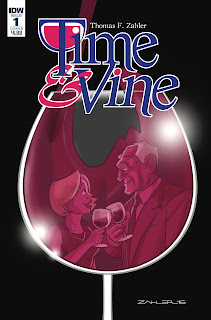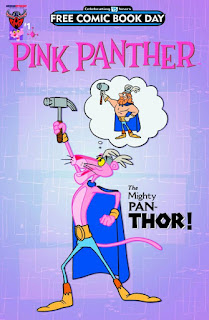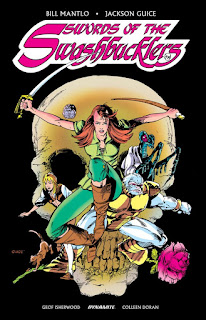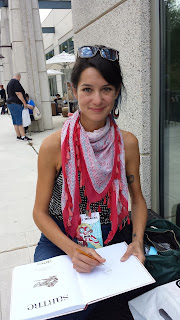 |
| Zahler at BCC in 2014 |
by Mike Rhode
Thom Zahler has
been one of my favorites working long-term in a ‘cartoony’ style in comic books. His Love and Capes series in particular used a
series of Justice League analogues to tell a long romance story. He’s a regular
at Baltimore Comic Con (BCC) and recently answered our usual interview
questions.
I write and draw comics. I letter and color most of my own work, too.
Basically, I do it all. (I did have a colorist on my recent Time and Vine
series, though.)
How do you do it? Traditional pen and ink,
computer or a combination?
These days, I’m mostly digital, in Clip Studio Paint, coloring in
Photoshop and lettering in Illustrator. I still draw by hand when I can,
especially commissions at conventions. And when I work on the right project,
like My Little Pony, I do work traditionally so I have art for the resale
market.
Early Seventies.
What is your training and/or education in
cartooning?
I took all the drawing classes I could in high school, as well as
creative writing and working on the newspaper comic strip. After that, I went
to and graduated from the Joe Kubert School of Cartoon and Graphic Art in
Dover, New Jersey.
Who are your influences?
Curt Swan was the first artist I ever recognized. I wanted to be George
Pérez like most people reading in the eighties. But Kurt Schaffenberger and Ty
Templeton were big influences as I started finding my wheelhouse. And these
days, it’s the late Darwyn Cooke.
 You've got a very 'cartoony'
style (which I love), but has it worked for or against you in getting jobs? Do
you have a more "realistic" style?
You've got a very 'cartoony'
style (which I love), but has it worked for or against you in getting jobs? Do
you have a more "realistic" style?
I used my realistic style on my Raider book, which went nowhere. I
think I can pull it off, but it’s like going uphill. And my realistic style
isn’t as magnetic as my cartoon style. I’m a decent serviceable realistic
artist but a good cartoon artist. So I’m going with my strengths.
The cartoony stuff has worked fine, but I’m also pitching it where I
think it works. I’ve drawn Strawberry Shortcake covers, pitched on other
cartoony stuff. I know I’m not the artist to draw monthly Superman books, so
I’m not aiming for those.
The only difference it really makes is in the stories I choose to tell.
I have a spy book I’d love to do, but I’m not the artist for it. But Warning Label, Love and Capes and even Time and Vine, I’m good for. I mentioned Darwyn
Cooke before, and he’s who I follow. His stuff works on almost everything, but
he also told very Darwyn Cooke stories.
Warning Label is partly about a woman board game designer - are you a gamer?
I play games, and wish I had the time and opportunity to play more, but I’m not hard core. Also, I don’t really play console games at all. It’s how I get things done.
Warning Label is partly about a woman board game designer - are you a gamer?
I play games, and wish I had the time and opportunity to play more, but I’m not hard core. Also, I don’t really play console games at all. It’s how I get things done.
If you could, what in your career would you
do-over or change?
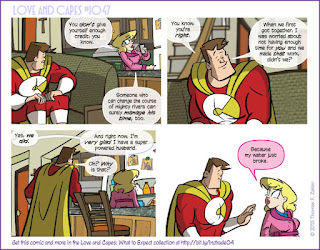 I would take some art history classes. I wish that I had the
opportunity to learn more about classic artists. I might have tried moving out
to LA to pursue more writing opportunities.
I would take some art history classes. I wish that I had the
opportunity to learn more about classic artists. I might have tried moving out
to LA to pursue more writing opportunities.
What work are you best-known for?
It's a toss-up. Love and Capes is what most comic readers know me from,
but my work on My Little Pony is by far the biggest title I’ve had the
privilege to work on.
Which came first, the Capes
webcomic or the comic book?
The LNC print comic always came first. The four-panel beat thing was
done for two reasons. One, back then everyone thought half-pages were the
secret to webcomics, so being able to have a format that embraced that meant I
could repurpose as a web strip if I liked doing the book but couldn’t afford to
publish print editions. And two, four-panel beats is a natural comedic
metronome to a guy like me who learned so much of his comedy from Bloom
County.
How did you get involved with My
Little Pony?
I was trying to impress my girlfriend at the time. She was a fan, and
IDW was already publishing Love and Capes. So I asked if I could do a cover,
because I knew they’d do a few. Bobby, the editor, knew my work and asked if I
wanted to pitch the book. Not being an idiot, I said “Absolutely” and went home
and mainlined the show to research it.
What work are you most proud of?
I'm still very proud of the last arc of Love and Capes. It’s heartfelt
and really sticks the landing, and part of why I haven’t ever come back to
that. But, I feel like every new project is stretching my artistic muscles in
new ways. I’m very happy with Warning Label.
Your new book, Time and Vine, is
currently being published by IDW. What's it about? How long is it planned to
run?
It’s about a magical time traveling winery, where when you go into the
right tasting room and you drink the right bottle of wine from 1912, you go
back to 1912 until you sober up. It’s a four issue miniseries, each issue
double-sized so it’s like eight issues total, and the last issue just came out.
It’s built to do more when I’m ready, and when I have time.
My copies of #2 and 3 from my comics store had
the same cover - I assume there was a mix-up in production?
Yeah, pretty much. Mistakes were made, they won’t happen again. The
alternate covers, the 1980’s cover on #2 and the 1860’s cover on #3 did print
correctly. So only half the issues of #3 are misprinted.
What would you like to do or work on in the
future?
I'd like to write more animation. I’d like to work on some mainstream
superhero book at some point. But past that, I am very happy with my personal,
creator-owned work.
What do you do when you're in a rut or have
writer's block?
I take a lot of walks get over story points. And I’ll try to draw
something fun to clear out the cobwebs as well.
What do you think will be the future of your
field?
I think that I’m in a good place, but it should never be comfortable.
Things have changed so much just in my short time in the field. There’s no way
that I could have done Love and Capes ten years earlier. Computer coloring made
things possible that I wouldn’t have been able to afford. And now, webcomics
are getting my stories known in ways that I never expected.
My feeling is that the game is always changing. The only constant is
that I have to learn to adapt to it.
How was your BCC experience? How often have
you attended it?
I’ve been going to BCC for over ten years. It’s one of my favorite
shows. I just adore it, and I love the fans and the pros and everything about
it. My favorite thing about the show is that it’s still a comic book show.
They’re surgical about bringing in media guests, and keep the focus on comics.
What's your favorite thing about
Baltimore? Least favorite?
As far as Baltimore itself, I do love the inner harbor. The humidity.
The Cleveland Art Museum and the Jefferson Memorial.
How about a favorite local restaurant?
My favorite place here in town, Taco Local, just closed. Right now it’s
a place called Brim. And when I’m in Baltimore, Miss Shirley’s.
Where is "here in town?"
I live just outside of Cleveland, Ohio, birthplace of Superman.
Do you have a website or blog?
 | |
| Warning Label webcomic |
My website is www.thomz.com. I’m
also on Twitter and Instagram @thomzahler
updated 10/24/2017 with gaming question
updated 10/24/2017 with gaming question



